2.4 Organic and Inorganic Compounds
Organic and Inorganic Compounds[1]
This section focuses on the chemistry of human life, meaning compounds that are important for the body’s structure and function. Recall that compounds are molecules made up of two or more atoms of different elements. Compounds are classified as either organic or inorganic:
- Organic compounds are molecules that contain both carbon and hydrogen. Organic compounds are made by covalent bonds. Carbon and hydrogen are the second and third most abundant elements in your body. Most organic compounds in the cells of the body belong to one of four classes: carbohydrates, lipids, proteins, and nucleotides.[2]
- Inorganic compounds do not contain carbon-hydrogen bonds and rarely contain carbon. They are compounds that contain ionic bonds. A lot of inorganic compounds contain hydrogen atoms, such as water (H2O) and the hydrochloric acid (HCl) produced by your stomach. Only a few inorganic compounds contain carbon atoms. Carbon dioxide (CO2) is one of the few examples. The three groups of inorganic compounds essential to life are water, acids, and bases.[3]
Organic and inorganic compounds are further discussed in the following subsections.
Organic Compounds in the Human Body
There are four major organic compounds (also called biomolecules) found in the human body: carbohydrates, lipids (fats), proteins, and nucleotides. Each of these compounds is discussed in the following subsections.
Carbohydrates
Carbohydrates are macromolecules with which most people are somewhat familiar. To lose weight, some individuals adhere to “low-carb” diets. Athletes, in contrast, often “carb-load” before important competitions to ensure that they have sufficient energy to compete at a high level. Carbohydrates are, in fact, an essential part of our diet; grains, fruits, and vegetables are all natural sources of carbohydrates. Carbohydrates provide energy to the body, particularly through glucose, a simple sugar. Carbohydrates also have other important functions in humans, animals, and plants. Carbohydrates contain carbon, hydrogen, and oxygen. Carbohydrates are classified into three subtypes: monosaccharides, disaccharides, and polysaccharides.
Monosaccharides
Monosaccharides (mono- = “one”; sacchar- = “sweet”) are simple sugars, the most common of which is glucose. Most sugar names end with the suffix -ose. The chemical formula for glucose is C6H12O6. Glucose is an important source of energy. During cellular respiration, energy is released from glucose, and that energy is used to help make adenosine triphosphate (ATP), which is a form of energy for the cell. Ribose, deoxyribose, galactose (part of lactose, or milk sugar), and fructose (found in fruit) are other common monosaccharides. See Figure 2.14[4] for an illustration of five important monosaccharides.
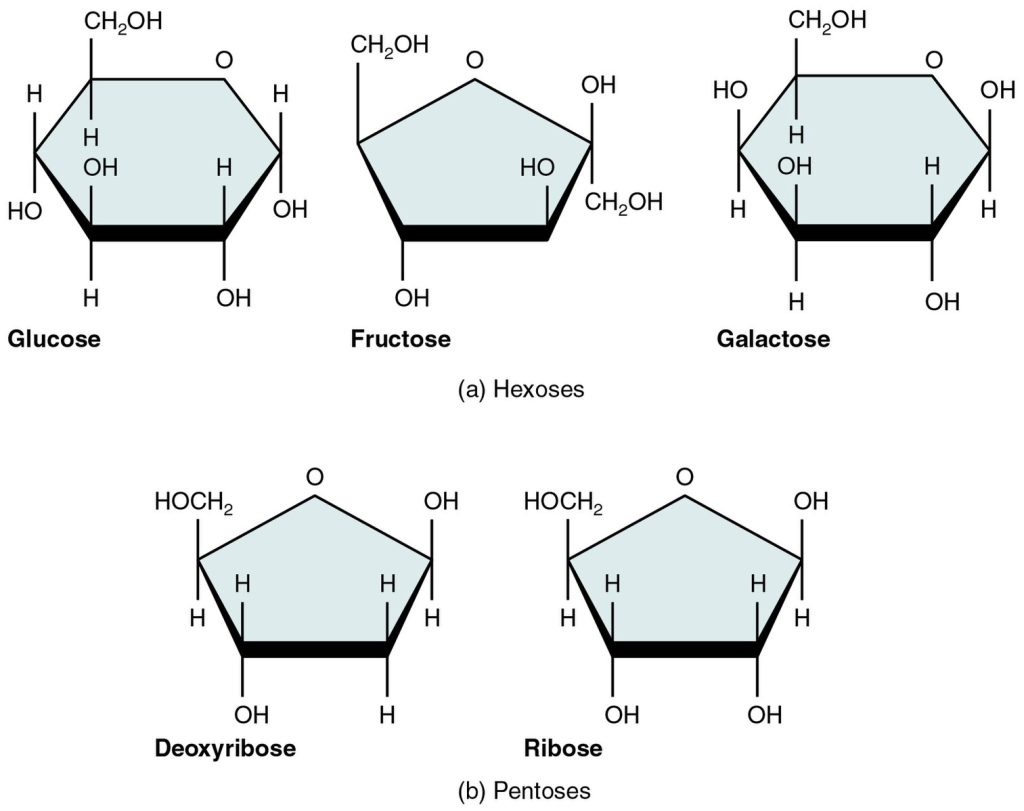
Disaccharides
Disaccharides (di- = “two”) form when two monosaccharides join together with a covalent bond.
Common disaccharides include lactose, maltose, and sucrose. Lactose is a disaccharide consisting of the monomers glucose and galactose. It is found naturally in milk. Maltose, or malt sugar, is a disaccharide formed between two glucose molecules. The most common disaccharide is sucrose, or table sugar, which is composed of glucose and fructose. See Figure 2.15[5] for an illustration of disaccharides.

Polysaccharides
A long chain of monosaccharides linked by covalent bonds is known as a polysaccharide (poly- = “many”). Polysaccharides may be very large molecules. Starch, glycogen, and cellulose are examples of polysaccharides:
- Starch is the storage form of glucose in plants and is relatively easy for humans to digest.
- Glycogen is the storage form of glucose in humans and other animals and is made up of monomers (building blocks) of glucose bonded together into long chains. Glycogen is usually stored in liver and muscle cells. Whenever glucose levels decrease, glycogen is broken down to release glucose.
- Cellulose is a component of plant cell walls. It is commonly known as “fiber” in the diet. Humans can’t digest cellulose, but it has many health benefits. Fiber helps you feel full, promotes a healthy digestive tract, and can reduce the risk of heart disease and some forms of cancer.
See Figure 2.16[6] for an illustration of these polysaccharides.

Lipids
Lipids or fats are a second type of organic compound that share a common feature. Lipids are hydrophobic (“water-fearing”), or insoluble in water, because they are nonpolar molecules. Lipids are large molecules that serve as a second source of fuel for the human body. All lipids contain carbon, hydrogen, and oxygen. Lipids perform many different functions in a cell. Cells use lipids to store energy for long-term use, provide insulation, make up cell membranes, and make some hormones. Lipids important to the human body include triglycerides, phospholipids, steroids, and prostaglandins.
Triglycerides
Triglycerides are the most common lipid (fat) in body tissues and the most common lipid in the human diet. Triglycerides are composed of a glycerol molecule with three fatty acid groups attached. The three fatty acids in the fat may be the same or different. Fatty acids may be saturated or unsaturated. In a fatty acid chain, if there are only single bonds between neighboring carbons, the fatty acid is saturated. When the carbon chain contains one or more double bonds, the fatty acid is unsaturated. See Figure 2.17[7] for an illustration of a triglyceride molecule.

When a person is resting or asleep, most of the energy used is derived from triglycerides stored in adipose tissue (fat). Triglycerides also fuel long, slow physical activities, such as gardening or hiking, and also contribute a percentage of energy to vigorous physical activity. Dietary fat assists in the absorption of fat-soluble vitamins A, D, E, and K. Stored body fat protects and cushions the body’s bones and internal organs and acts as insulation to retain body heat. There are different types of triglycerides called saturated fats, unsaturated fats, and trans fats.
Some fatty acids have common names that specify their origin. For example, palmitic acid is derived from the palm tree. Arachidic acid is derived from Arachis hypogaea, the scientific name for peanuts.
Saturated fats are solid or semi-solid at room temperature. For example, butter is a dietary saturated fat. Fat in steak is also saturated fat. Saturated fats contain only single bonds in their chemical structure. Saturated fats are considered unhealthy, and diets high in saturated fats have been linked to heart disease.
Unsaturated fats are liquid at room temperature. They contain one or more double bonds in their chemical structure. If there is one double bond in the molecule, then it is called a monounsaturated fat, and if there is more than one double bond, then it is known as a polyunsaturated fat. Plant oils, such as olive oil and avocado oil, as well as the fat in salmon, are examples of unsaturated fats. These types of fats are considered healthier than saturated fats, and diets high in unsaturated fats help reduce the risk of heart disease.
Trans fats are created from unsaturated fatty acids (such as corn oil) when they are chemically treated to produce partially hydrogenated fats. Trans fats are commonly found in processed foods, such as margarine, fried foods, and commercially baked products. They are even more harmful to the heart and blood vessels than saturated fats. Many fast-food restaurants have recently eliminated the use of trans fats, and U.S. food labels are now required to list their trans fat content.
Essential fatty acids are fatty acids that are required but not made by the human body, so they must be supplemented through the diet. Omega-3 fatty acids fall into this category and are one of only two known essential fatty acids for humans (the other being omega-6 fatty acids). They are a type of polyunsaturated fat and are called omega-3 fatty acids because the third carbon from the end of the fatty acid participates in a double bond.
Salmon, trout, and tuna are good sources of omega-3 fatty acids. Omega-3 fatty acids are important in brain function and normal growth and development. They may also prevent heart disease and reduce the risk of cancer.
Like carbohydrates, fats have received a lot of bad publicity. It is true that eating an excess of fried foods and other “fatty” foods leads to weight gain. However, fats do have important functions. Fats serve as long-term energy storage and provide insulation for the body. Therefore, “healthy” unsaturated fats in moderate amounts should be consumed on a regular basis.
Phospholipids
Phospholipids are the main component of cell membranes, which protect cells from environmental damage and allow for cellular processes. Phospholipids are found in dairy milk and chicken eggs. Like triglycerides, they are composed of fatty acid chains attached to a glycerol backbone. Instead of three fatty acids attached however, there are two fatty acids, and the third carbon of the glycerol backbone is bound to a phosphate group.
A phospholipid has both hydrophobic and hydrophilic regions. The fatty acid chains or tails are hydrophobic and are arranged in a bilayer (two rows) in the cell membrane so that the tails point inwards to protect them from the watery environments inside and outside of the cell. The phosphate is hydrophilic and interacts with water. See Figure 2.18[8] for an illustration of a phospholipid and Figure 2.19[9] for an illustration of the phospholipid bilayer.
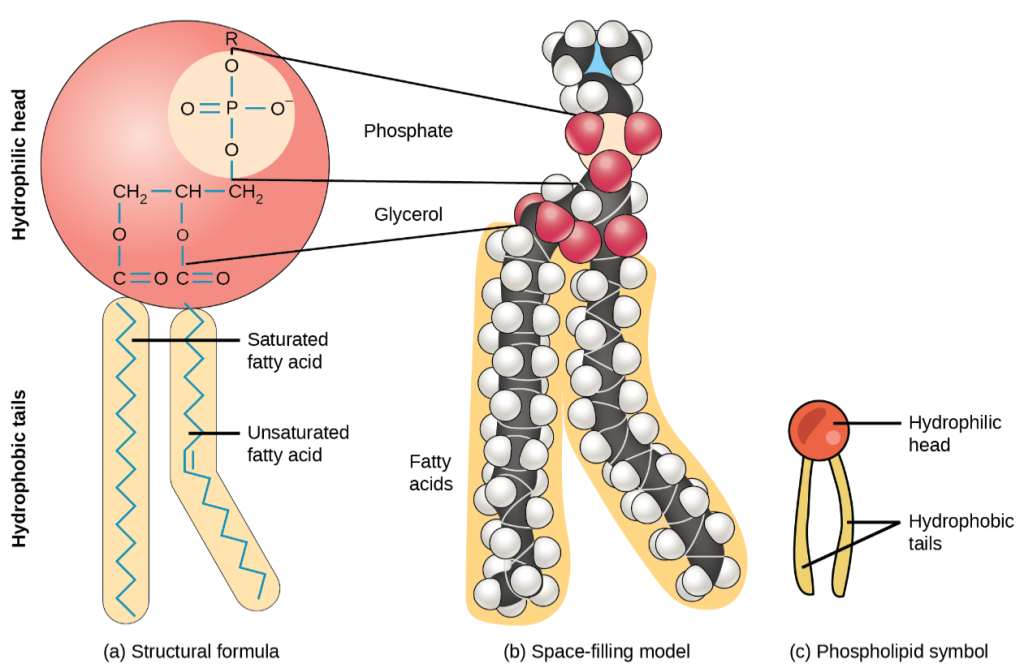
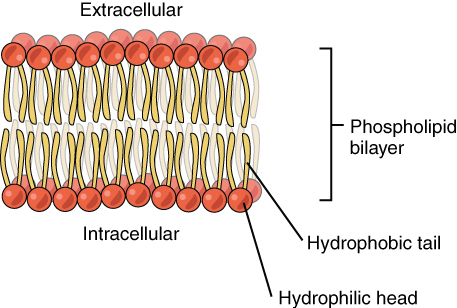
Steroids
Steroids are classified as lipids because they are hydrophobic and insoluble in water. All steroids have four rings of carbon atoms linked together in their chemical structure. Cholesterol is the most common steroid in the human body and is the building block of many hormones. It is also used in digestion, vitamin D synthesis, and formation of cell membranes. Cholesterol is made by the liver and is also present in most animal products, such as meats, eggs, and dairy products. Although cholesterol is often spoken of in negative terms, it is necessary for the proper functioning of the body. See Figure 2.20[10] for an illustration of the steroids cholesterol and cortisol.
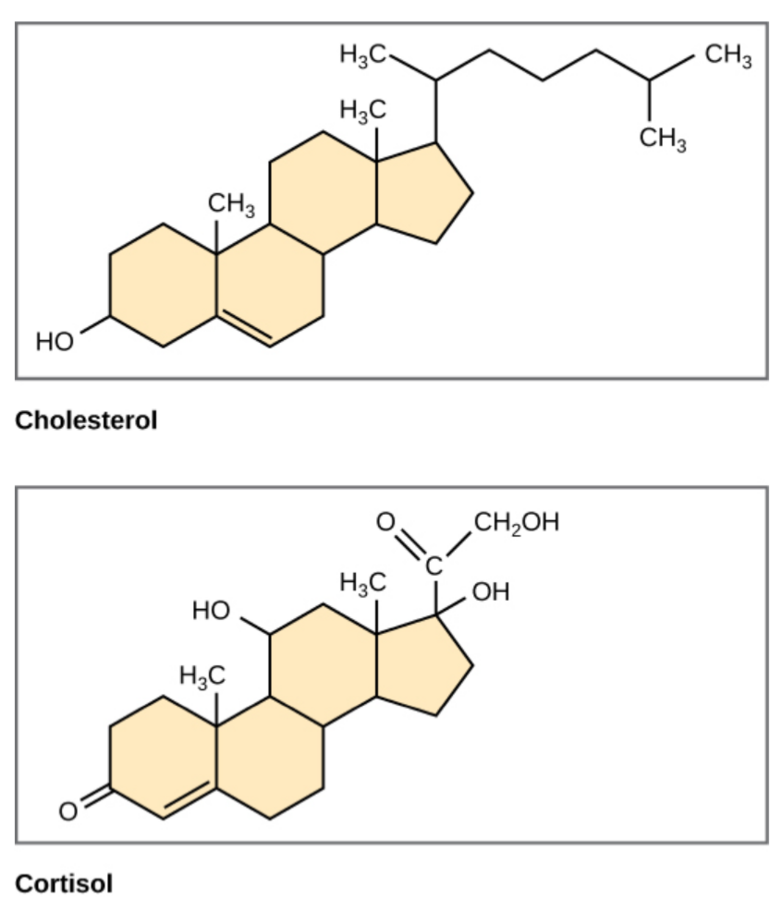
Prostaglandins
Like a hormone, a prostaglandin is one of a group of signaling molecules derived from unsaturated fatty acids. One reason that the omega-3 fatty acids found in fish are beneficial is that they stimulate the production of certain prostaglandins that help regulate aspects of blood pressure and inflammation and, thereby, reduce the risk for heart disease. Prostaglandins also sensitize nerves to pain. One class of pain-relieving medications called nonsteroidal anti-inflammatory drugs (NSAIDs), like ibuprofen and naproxen, works by reducing the effects of prostaglandins.
Proteins
Proteins are a third type of organic compound that are critical components of all tissues and organs. Proteins include the collagen found in skin, the hemoglobin that carries oxygen in the blood, and the actin and myosin responsible for muscle movement. Proteins also make up digestive enzymes (catalysts that help speed up chemical reactions), antibodies, the neurotransmitters that nerve cells use to communicate with other cells, and some hormones. Hormones are chemical signaling molecules that control specific physiological processes, including growth, development, metabolism, and reproduction. For example, insulin is a protein hormone that maintains blood glucose levels. The body can also use proteins for energy when dietary intake of carbohydrates and fat is inadequate, and stores of glycogen and adipose tissue become depleted. However, because there is no storage site for protein except in functional tissues, using protein for energy causes tissue breakdown and results in body wasting.
A protein is an organic molecule made up of building blocks called amino acids that are linked by peptide bonds. A peptide bond is a covalent bond between two amino acids that forms by dehydration synthesis (the elimination of water to combine molecules). Just 20 different amino acids make up thousands of different proteins in the human body by joining together to form protein polymers. Each type of protein contains a unique combination of these 20 amino acids, ranging from a few dozen to several hundred. A peptide is a very short chain of amino acids, and strands containing fewer than 100 amino acids are generally referred to as polypeptides rather than proteins. See Figure 2.21[11] for an illustration of a peptide bond.
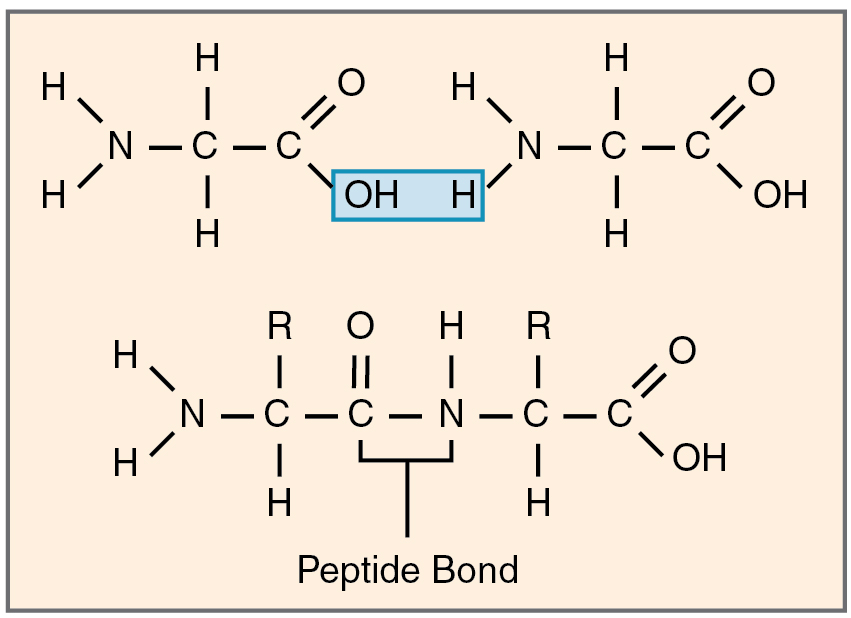
The human body can produce most amino acids, but nine amino acids cannot be made by the body and must be consumed in the diet. These are known as the essential amino acids.
Proteins have different shapes; some proteins are globular in shape whereas others are fibrous in nature. For example, hemoglobin is a globular protein, but collagen, found in our skin, is a fibrous protein. Protein shape is critical to its function. Changes in temperature, pH, and exposure to chemicals may lead to permanent changes in the shape of the protein, leading to a loss of function or denaturation (which will be discussed in more detail later). All proteins are made up of different arrangements of the same 20 amino acids.
The sequence and number of amino acids ultimately determine a protein’s shape, size, and function. Each amino acid is attached to another amino acid by a covalent bond, known as a peptide bond. As discussed earlier, the shape of a protein is critical to its function. To understand how the protein gets its final shape or conformation, we need to understand the four levels of protein structure: primary, secondary, tertiary, and quaternary. See Figure 2.22[12] for an illustration of four levels of protein structure.
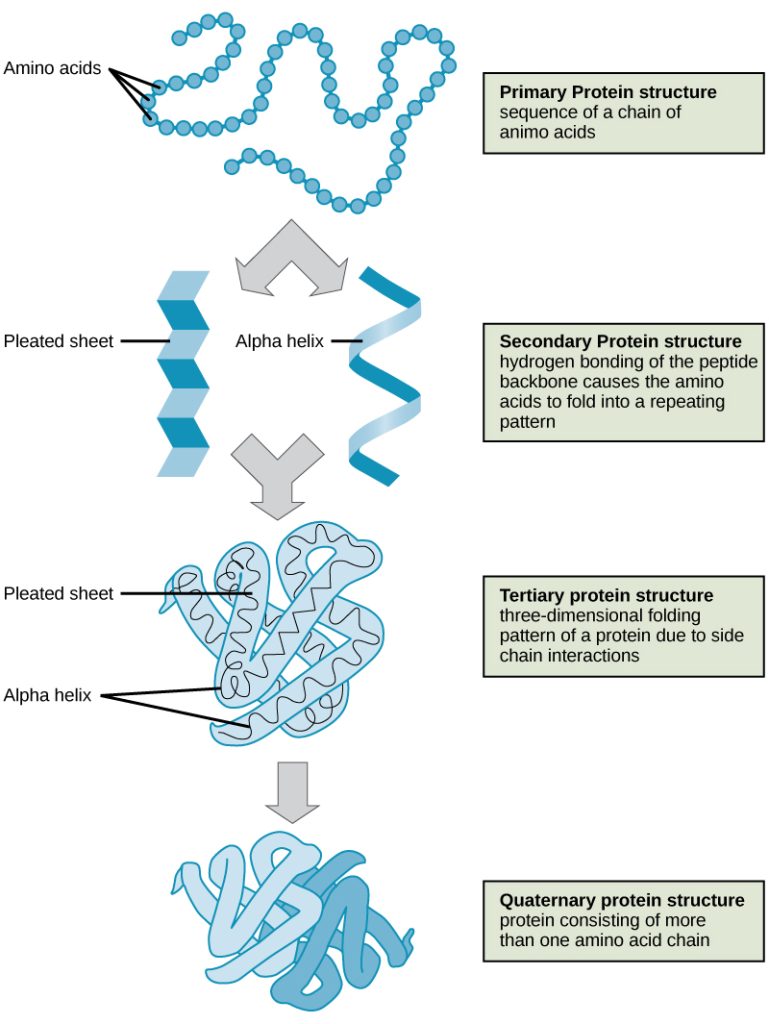
The unique sequence and number of amino acids in a polypeptide chain is its primary structure.
The unique sequence for every protein is ultimately determined by the gene that encodes the protein. Any change in the gene sequence may lead to a different amino acid being added to the polypeptide chain, causing a change in protein structure and function. For example, sickle cell anemia is caused by a change in protein structure as a result of gene encoding, meaning that it is an inherited disorder. In sickle cell anemia, the hemoglobin β chain has a single amino acid substitution, causing a change in both the structure and function of the protein. What is most remarkable to consider is that a hemoglobin molecule is made up of two alpha chains and two beta chains that each consist of about 150 amino acids. The molecule, therefore, has about 600 amino acids. The structural difference between a normal hemoglobin molecule and a sickle cell molecule—that dramatically decreases life expectancy in the affected individuals—is a single amino acid of the 600. Because of this change of one amino acid in the chain, the normally biconcave, or disc-shaped, red blood cells assume a crescent or “sickle” shape, which clogs arteries. This can lead to a myriad of serious health problems, such as breathlessness, dizziness, headaches, and abdominal pain for those who have this disease.
Each protein has its own unique sequence and shape held together by chemical interactions. If the protein is subject to changes in temperature, pH, or exposure to chemicals, the protein structure may change, losing its shape in what is known as denaturation as discussed earlier. Denaturation is often reversible because the primary structure is preserved if the denaturing agent is removed, allowing the protein to resume its function. Sometimes denaturation is irreversible, leading to a loss of function. One example of protein denaturation can be seen when an egg is fried or boiled. The albumin protein in the liquid egg white is denatured when placed in a hot pan, changing from a clear substance to an opaque white substance. Not all proteins are denatured at high temperatures; for instance, bacteria that survive in hot springs have proteins that are adapted to function at those temperatures.
Enzymes
For atoms to react and form bonds, they must come into contact with each other, which often occurs due to random collisions. Higher temperatures (caused by the transfer of energy) cause chemical reactions to occur at a faster rate due to faster movement of atoms, ions, and molecules. The faster the movement, the more likely they are to come in contact with each other and react. However, in the human body, higher temperatures, such as a high fever, can damage body cells and become life-threatening. On the other hand, a normal body temperature is not high enough to promote the chemical reactions that sustain life. For this reason, catalysts known as enzymes are critical to facilitate chemical reactions and molecular bonding that occurs in the human body.
A catalyst is a substance that increases the rate and force at which atoms, ions, and molecules collide, thereby increasing the chances that the electrons in their valence shells will interact. An enzyme is a catalyst usually composed of protein, although there are a few enzymes that are made from ribonucleic acid (RNA) instead. Like all catalysts, enzymes work by lowering the amount of energy (e.g., heat) that is required to start a chemical reaction. Without an enzyme acting as a catalyst, a much larger amount of energy is needed to start a chemical reaction. See Figure 2.23[13] for an illustration of the energy required to start a reaction without an enzyme compared to that required for a reaction with an enzyme. Enzymes decrease the amount of energy required for a chemical reaction to occur.
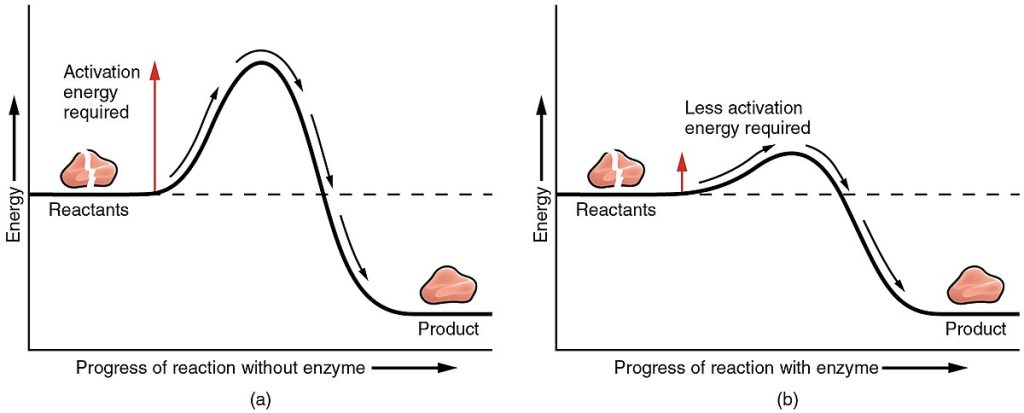
Nucleotides
Nucleotides are the fourth type of organic compound in the human body and are used to build nucleic acids (DNA or RNA) and adenosine triphosphate (ATP). Nucleic acids are key macromolecules in the continuity of life. They carry the genetic blueprint of a cell and carry instructions for the functioning of the cell. ATP is an important energy molecule for cells in the body.
The two main types of nucleic acids are deoxyribonucleic acid (DNA) and ribonucleic acid (RNA). DNA is the genetic material found in all living organisms, ranging from single-celled bacteria to multicellular humans. The other type of nucleic acid, RNA, is mostly involved in protein synthesis. The DNA molecules never leave the nucleus but instead use different types of RNA to manufacture proteins using instructions from the DNA’s genetic code.
Molecules called nucleotides are the building blocks of both DNA and RNA that hold the instructions on how to build and maintain the human body. A nucleotide consists of the following:
- A sugar molecule (i.e., deoxyribose in DNA or ribose in RNA)
- A phosphate group
- A nitrogen-containing base
- In DNA, the bases are adenine (A), cytosine (C), guanine (G), and thymine (T).
- In RNA, the base uracil (U) takes the place of thymine.
DNA and RNA molecules are polymers made up of long chains of nucleotides. See Figure 2.24[14] for an illustration of the structure of a nucleotide. The following subsections will further explain the structure of DNA, RNA, and chromosomes.
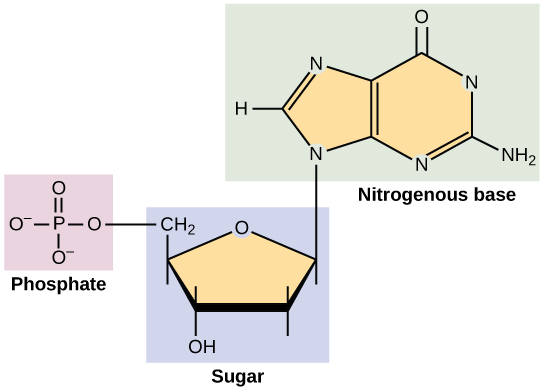
DNA
DNA is found in the nucleus of every cell in the human body, except for red blood cells. The primary structure of DNA is a double helix, where two strands of nucleotides wind around each other like a spiral staircase. When learning about the structure of DNA, it is helpful to think of it like a ladder. The sides of the ladder are made of alternating sugar (deoxyribose) and phosphate groups. The rungs of the ladder are made up of pairs of the nitrogen-containing bases adenine (A), thymine (T), cytosine (C), or guanine (G). Note that adenine always pairs with thymine (A-T), and guanine always pairs with cytosine (G-C). The bases are held together with hydrogen bonds. See Figure 2.25[15] for an illustration of the double helix structure of DNA.[16]

DNA stays within the nucleus and is very accurate at copying itself during a process called replication. The sequence of the base pairs (i.e., the As, Ts, Cs, and Gs) form genes. Humans have about three billion base pairs, making almost 22,000 genes in their DNA. DNA is unique for each individual except identical twins. Genes are contained in 46 chromosomes inside the nucleus of each cell and are passed from generation to generation. Chromosomes can be seen through a microscope when the nucleus dissolves during cell division. See Figure 2.26[17] for an illustration of chromosomes.

RNA
Ribonucleic acid (RNA) is also made up of building blocks called nucleotides that contain a sugar molecule attached to a phosphate group and nitrogen-containing bases. However, unlike the double-stranded DNA, RNA is single-stranded. The sugar molecule is ribose, and uracil replaces thymine as a nitrogenous base. When DNA makes RNA during a process called transcription, cytosine always pairs with guanine, just like in DNA, but in RNA, adenine pairs with uracil instead. RNA is located inside and outside the nucleus. RNA synthesis is less accurate than DNA replication, so a strand of RNA may contain more errors or mutations than DNA. RNA plays a vital role in protein synthesis, including carrying the genetic code from DNA to the ribosomes (a cell structure discussed in Chapter 3) and helping to assemble amino acids into proteins. See Figure 2.27[18] for an illustration of RNA. Table 2.1 summarizes the differences between DNA and RNA.
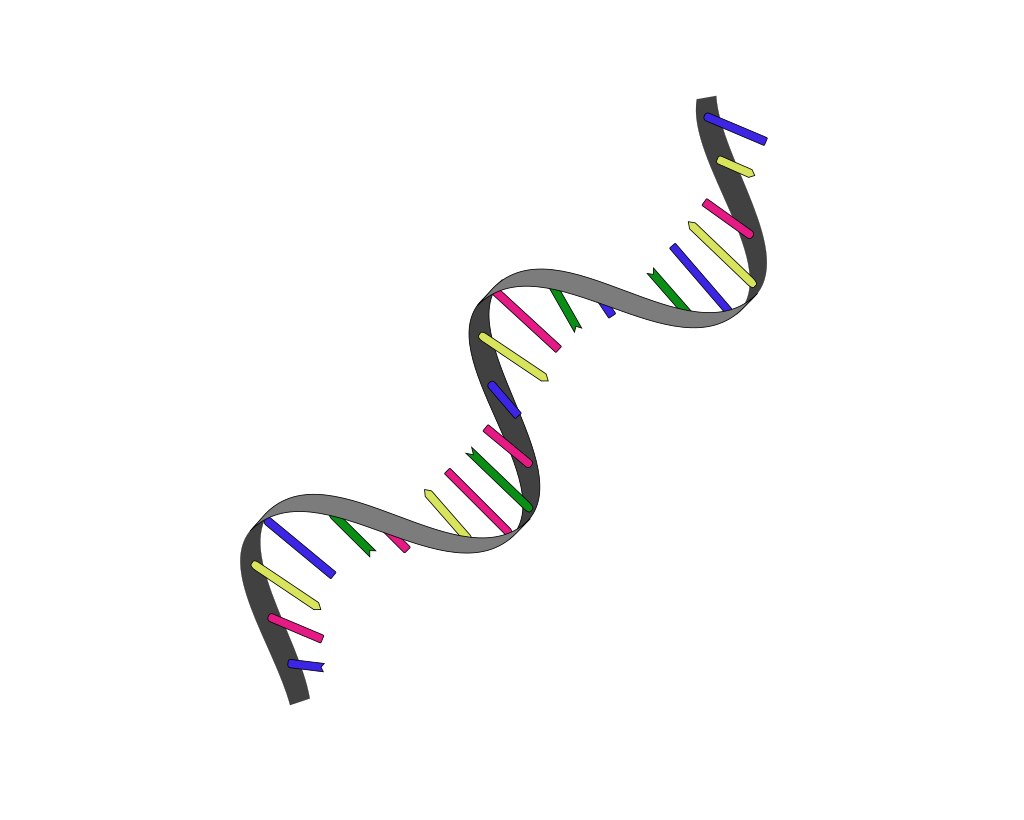
Table 2.1. DNA Compared to RNA
| DNA | RNA | |
|---|---|---|
| Number of Strands | Double-stranded | Single-stranded |
| Sugar | Deoxyribose | Ribose |
| Nitrogenous Bases | Adenine, cytosine, guanine, and thymine | Adenine, cytosine, guanine, and uracil |
| Location | Never leaves the nucleus | Found inside and outside the nucleus |
| Types | One type of DNA | Several types of RNA:
|
| Copying Accuracy | Excellent at copying itself | More mistakes are made during RNA synthesis |
View a supplementary YouTube video[19] on DNA and RNA at DNA vs RNA (Updated).
Adenosine Triphosphate
The nucleotide adenosine triphosphate (ATP) is composed of a ribose sugar, an adenine base, and three phosphate groups. ATP is classified as a high-energy compound because the two covalent bonds linking its three phosphates store a significant amount of potential energy. In the body, the energy released from these high-energy bonds helps fuel all of the body’s functions, such as contracting muscles, maintaining the electrical potential of nerve cells, and absorbing food in the gastrointestinal tract. The products of this reaction are a molecule of adenosine diphosphate (ADP) and a lone phosphate group (Pi). ATP, ADP, and Pi are constantly being cycled through reactions that build ATP and store energy and reactions that break down ATP and release energy. The metabolic reactions that produce ATP come from various sources. See Figure 2.28[20] for an illustration of the structure of ATP.
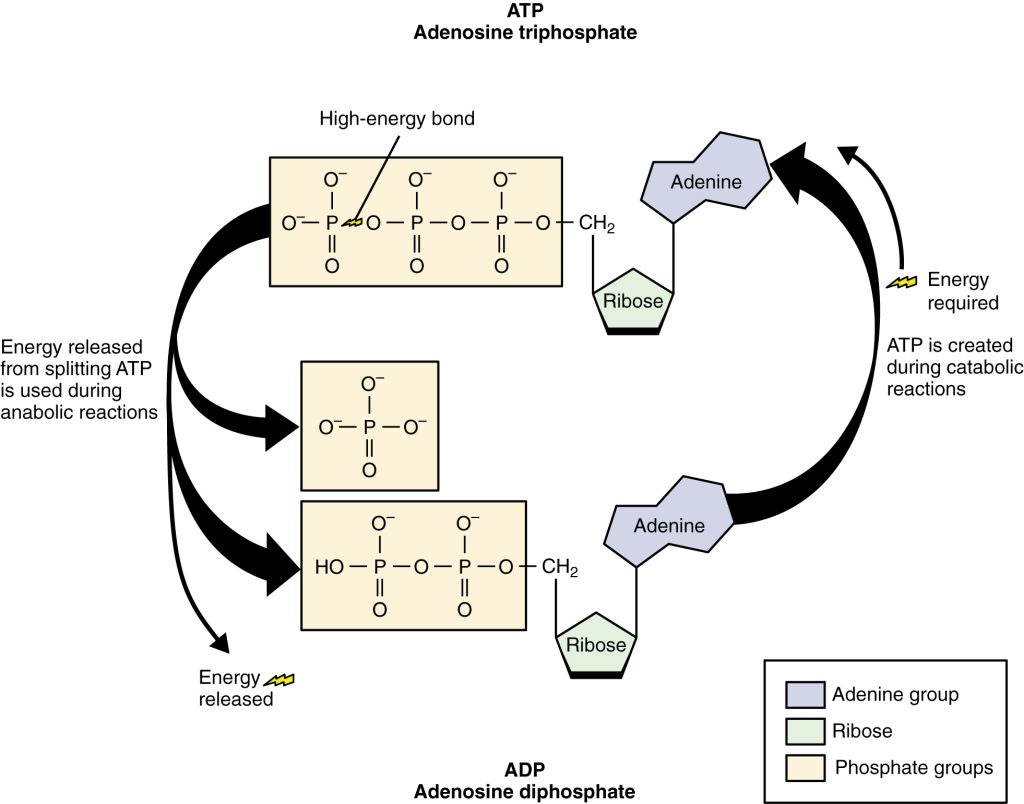
View a supplementary YouTube video[21] on biomolecules: Biomolecules (Updated 2023).
Inorganic Compounds
Water
As much as 70 percent of an adult’s body weight is water. This water is contained both inside and outside the cells that make up tissues and organs. Water has several important roles in the body, including the following:
- Lubricant. Water is a major component of many of the body’s lubricating fluids. Just as oil lubricates the hinge on a door, water lubricates the body joints, helps the lungs expand and recoil with breathing, keeps food moving through the digestive tract, and allows the abdominal organs to stay friction free.
- Cushion. Water is also used as a cushion to protect structures throughout the body. It protects cells and organs from physical trauma, cushions the brain within the skull, and even protects a developing fetus in the mother’s uterus.
- Heat Regulator: In the body, water acts as a heat sink by absorbing the heat generated by chemical reactions without greatly increasing the body’s temperature. Water stored in the body helps keep the body temperature cool when the environmental temperature soars. This cooling effect happens as warm blood from the body’s core flows to the blood vessels just under the skin and is transferred to the environment. At the same time, sweat glands release warm water as sweat. As the water evaporates into the air, it carries away heat, and cooler blood circulates back to the body core.
- Component of Liquid Mixtures: A mixture is a combination of two or more substances that maintain their own chemical identity and are not chemically bonded into a larger substance. As an example, if you stir flour and sugar together in a bowl, they form a mixture but do not bond to form a new compound. There are three types of liquid mixtures that contain water as a key component called solutions, colloids, and suspensions.
Solutions
For cells in the body to survive, they must be kept moist in a water-based liquid called a solution. A liquid solution consists of a substance called a solute dissolved into a solvent (liquid). An important characteristic of solutions is that they are homogeneous, meaning the solute molecules are distributed evenly throughout the solution. For example, if you stir sugar into a glass of water, the sugar (solute) dissolves into sugar molecules separated by water molecules (the solvent). The ratio of sugar molecules to water molecules in the left side of the glass is the same as the ratio of sugar molecules to water molecules in the right side of the glass. If you were to add more sugar, the ratio of sugar molecules to water molecules would increase, but the distribution of molecules would still be even.
Water is the most abundant solvent in the body. Essentially all of the body’s chemical reactions occur among compounds dissolved in water. For this reason, water is considered the universal solvent, and it is believed that life cannot exist without water. Because water molecules are polar molecules, with regions of positive and negative electrical charge, water readily dissolves ionic compounds and polar covalent compounds. These types of compounds are referred to as hydrophilic (“water-loving”). Nonpolar molecules do not readily dissolve in water and are called hydrophobic (“water-fearing”). For example, sugar dissolves in water because sugar molecules contain regions of hydrogen-oxygen polar bonds, making it hydrophilic.
Concentrations of Solutes
The concentration of a solute is the number of particles of that solute in a given space. For example, when measuring blood glucose in the body, the concentration is measured in milligrams (mg) of glucose per deciliter (dL) of blood, which in a healthy adult is about 100 mg/dL.
Colloids
A colloid is a mixture that is like a heavy solution. The solute particles consist of tiny clumps of molecules that are large enough to make the liquid mixture look opaque because the particles are large enough to scatter light. For example, blood, mucus, tears, and breast milk are all examples of colloids in the human body.
Suspension
A suspension is a liquid mixture in which a heavier substance is suspended temporarily in a liquid, but over time, the substance settles out. This separation of particles from a suspension is called sedimentation.
An example of sedimentation in the human body is a diagnostic blood test called sedimentation rate. This test measures how quickly red blood cells in a test tube settle out of the watery portion of blood (known as plasma) over a set period of time. Rapid sedimentation of blood cells does not normally happen in a healthy person, but medical conditions producing inflammation cause the red blood cells to clump together and settle to the bottom of the test tube more quickly than normal. Therefore, an elevated sedimentation rate indicates inflammation is occurring in the body.
Acids and Bases
Acids and bases, like salts, dissolve in water into ions in the human body. Acids and bases can change the properties of the solutions in which they are dissolved.
Acids
An acid is a hydrogen-containing substance that releases hydrogen ions (H+) in a solution. Because a hydrogen atom has just one proton and one electron, a positively charged hydrogen ion is simply a proton. This solitary proton is very likely to participate in chemical reactions.
Strong acids are compounds that release all their H+ in a solution, meaning they ionize completely. For example, hydrochloric acid (HCl) that is released from cells in the lining of the stomach is a strong acid because it releases all of its H+ in the stomach’s watery environment. This strong acid aids in digestion and kills ingested microbes.
Weak acids do not ionize completely, meaning some of their hydrogen ions remain bonded within a compound in solution. An example of a weak acid is vinegar (acetic acid) that is called acetate after it gives up a proton (H+).
See Figure 2.29[22] for an illustration of acids and bases.
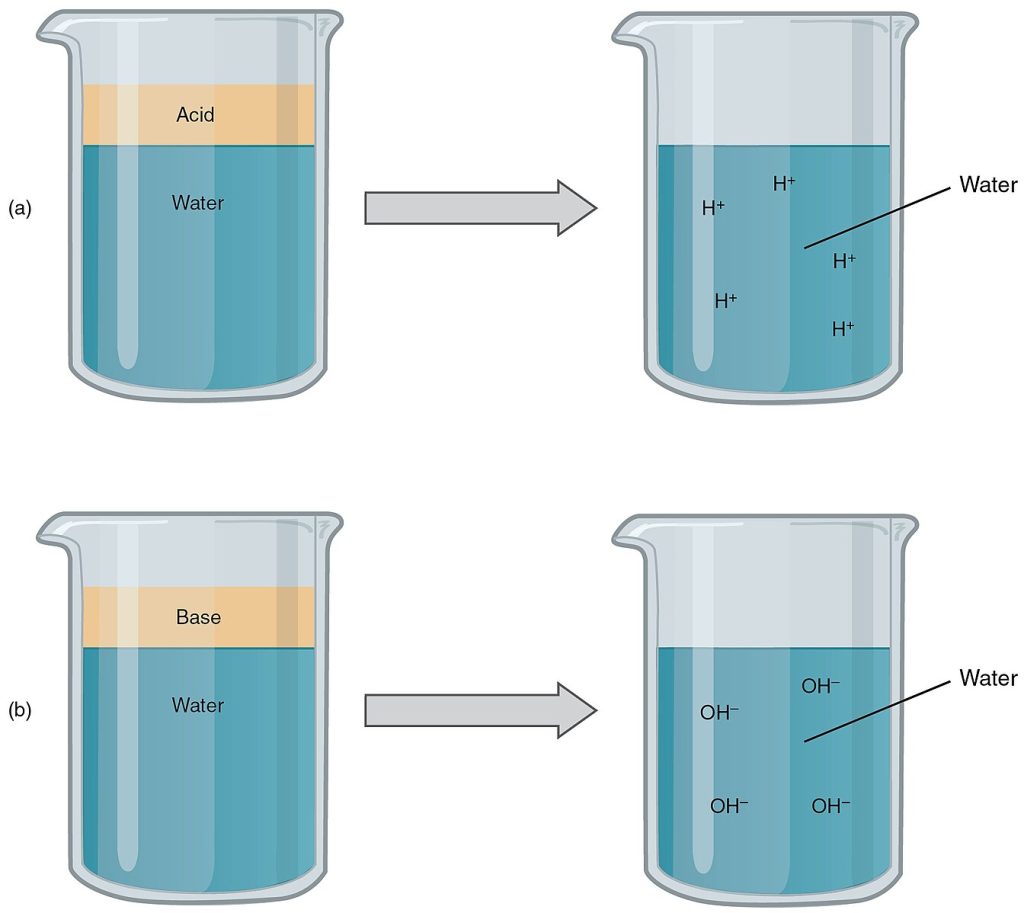
Bases
A base is a molecule in a solution that accepts hydrogen ions (H+) already present in the solution or releases hydroxyl ions (OH–). The hydroxyl ions (also known as hydroxide ions) combine with H+ to form a water molecule, thereby removing H+ and reducing the solution’s acidity. Review the illustration of bases in Figure 2.27 in the previous subsection.
Strong bases release most or all of their hydroxyl (OH–) ions. Weak bases release only some hydroxyl ions or absorb only a few H+. An example of a base in the human body is bicarbonate (HCO3–) that is secreted by the pancreas into the small intestine to neutralize stomach acid. Bicarbonate accepts some of the H+ protons, thereby reducing the acidity of the solution. If bicarbonate were not released, food mixed with hydrochloric acid would burn the small and large intestines.
Often the word alkaline is used to describe a solution that contains a base.
pH
The acidity or alkalinity of a solution is indicated by its pH, a measure of the concentration of hydrogen (H+) ions. The pH scale goes from 0 to 14, with numbers less than 7 being acids, 7 being neutral (neither acidic or basic), and pH numbers greater than 7 being bases. Smaller numbers on the pH scale are more acidic or have a greater concentration of H+. For example, a solution with a pH of 0 is a very strong acid whereas a solution with a pH of 6 would be a weak acid. Larger numbers on the pH scale are more basic (alkaline) and have a lower concentration of H+. A solution with a pH of 14 would be a very strong base compared to a solution with a pH of 8, which would be a weak base.
A change of one unit on the pH scale represents a change in the concentration of hydrogen ions by a factor of 10, and a change in two units represents a change in the concentration of hydrogen ions by a factor of 100. Thus, small changes in pH represent large changes in the concentration of hydrogen ions.
Pure water is neutral. It is neither acidic nor basic and has a pH of 7.0. The blood in your veins is slightly alkaline (pH = 7.4). The environment in your stomach is highly acidic (pH = 1 to 2), and saliva is a weak acid (pH = 6.3 to 6.6). The pH of semen is alkaline (pH = 7.2 to 8).
See Figure 2.30[23] for an illustration of the pH scale.

Blood Buffer
The pH of human blood normally ranges from 7.35 to 7.45. All cells of the body depend on homeostatic regulation of this acid–base balance for normal functioning. Maintaining a stable pH range is critical because fluctuations where the blood becomes too acidic or too alkaline disrupts cell and protein function and can lead to seizures, coma, or even death. At this slightly basic pH, blood can reduce the acidity that results from carbon dioxide (CO2) being constantly released into the bloodstream by the cells of the body. The body also has several homeostatic mechanisms for regulating acid-base balance, such as exhaling CO2 while breathing, excreting hydrogen or bicarbonate ions in the urine, and using buffers in body fluids.
A buffer refers to a chemical system within the body that is primarily composed of a weak acid and a weak base. Buffers attempt to maintain a stable pH level by neutralizing added acids and bases. For example, if the blood pH drops slightly below 7.35 and becomes more acidic, the blood buffer acts as a weak base and bicarbonate (HCO3–) binds to the excess hydrogen ions. In contrast, if blood pH rises slightly above 7.45, the blood buffer acts as a weak acid, and the carbonic acid (H2CO3) contributes hydrogen ions to make the blood more acidic.
- Betts, J. G., Desaix, P., Johnson, E., Johnson, J. E., Korol, O., Kruse, D., Poe, B., Wise, J., Womble, M. D., & Young, K. A. (2022). Anatomy and physiology, 2e. OpenStax. https://openstax.org/books/anatomy-and-physiology-2e/pages/1-introduction ↵
- Fowler, S., Roush, R., & Wise, J. (2013). Concepts of biology. OpenStax. https://openstax.org/books/concepts-biology/pages/1-introduction ↵
- Fowler, S., Roush, R., & Wise, J. (2013). Concepts of biology. OpenStax. https://openstax.org/books/concepts-biology/pages/1-introduction ↵
- “217_Five_Important_Monosaccharides-01” by OpenStax College is licensed under CC BY 3.0 ↵
- “Figure_03_02_05” by CNX OpenStax is licensed under CC BY 4.0 ↵
- “219_Three_Important_Polysaccharides-01” by OpenStax College is licensed under CC BY 3.0 ↵
- “220_Triglycerides-01” OpenStax College is licensed under CC BY 3.0 ↵
- “Struttura_dei_fosfolipidi” by unknown author is licensed under CC BY 4.0 ↵
- “0302_Phospholipid_Bilayer” by OpenStax is licensed under CC BY 4.0 ↵
- “Struttura_degli_steroidi” by unknown author is licensed under CC BY 4.0 ↵
- “224_Peptide_Bond-01” by OpenStax College is licensed under CC BY 3.0 ↵
- “Figure_03_04_09” by CNX OpenStax is licensed under CC BY 4.0 ↵
- “212_Enzymes-01” by OpenStax College is licensed under CC BY 3.0 ↵
- “e6fa7ba0d1dbdf77c6e6bc1370246dc305dc7a0a” by Rice University is licensed under CC BY 4.0. Access for free at https://openstax.org/books/concepts-biology/pages/2-3-biological-molecules ↵
- “cbc1ec6dbf6eb2c9574bbf7a3a3399a58996d89e” by OpenStax is licensed under CC BY 4.0. Access for free at https://openstax.org/books/anatomy-and-physiology-2e/pages/2-5-organic-compounds-essential-to-human-functioning ↵
- Fowler, S., Roush, R., & Wise, J. (2013). Concepts of biology. OpenStax. https://openstax.org/books/concepts-biology/pages/1-introduction ↵
- “NHGRI_human_male_karyotype" by National Human Genome Research Institute is in the Public Domain. ↵
- “201904_RNA” by DataBase Center for Life Science (DBCLS) is licensed under CC BY 4.0 ↵
- Ameoba Sisters. (2019, August 29). DNA vs RNA (Updated) [Video]. YouTube. All rights reserved. https://www.youtube.com/watch?v=JQByjprj_mA ↵
- “2a6147c3e109ac8295926abf3a16e3cf3b985148” by Rice University is licensed under CC BY 4.0. Access for free at https://openstax.org/books/anatomy-and-physiology-2e/pages/24-1-overview-of-metabolic-reactions ↵
- Amoeba Sisters. (2023, July 30). Biomolecules (Updated 2023) [Video]. YouTube. All rights reserved. https://www.youtube.com/watch?v=1Dx7LDwINLU ↵
- “215_Acids_and_Bases-01” by OpenStax College is licensed under CC BY 3.0 ↵
- “216_pH_Scale-01” by OpenStax College is licensed under CC BY 3.0 ↵
Molecules that contain both carbon and hydrogen.
Compounds which do not contain carbon-hydrogen bonds and rarely contain carbon.
Organic molecules that are essential for life including carbohydrates, proteins, lipids, and nucleic acids.
Provide energy to the body through glucose.
A simple sugar.
Simple sugars, the most common of which is glucose.
When two monosaccharides join together with a covalent bond.
A long chain of monosaccharides linked by covalent bonds.
The storage form of glucose in plants and is relatively easy for humans to digest.
The storage form of glucose in humans and other animals and is made up of monomers (building blocks) of glucose bonded together into long chains.
A component of plant cell walls, commonly known as “fiber” in the diet.
A diverse group of organic molecules that are primarily hydrophobic and insoluble in water. They include fats, oils, phospholipids, steroids, and waxes, and they play essential roles in energy storage, cell membrane structure, hormone production, and insulation.
A type of lipid (fat) composed of one glycerol molecule and three fatty acid chains. It is the main form of stored fat in the body and a major source of energy.
A type of connective tissue that stores energy in the form of fat.
A type of fat in which all the carbon atoms in the fatty acid chains are connected by single bonds, meaning they are "saturated" with hydrogen atoms.
A type of fat in which the fatty acid chains contain one or more double bonds between carbon atoms, meaning they are not fully saturated with hydrogen atoms.
A type of unsaturated fat that have been artificially modified through a process called hydrogenation, which adds hydrogen to liquid oils to make them more solid and shelf-stable.
The main component of cell membranes, which protect cells from environmental damage and allow for cellular processes.
A class of lipids characterized by their hydrophobic nature and insolubility in water. They have a distinct chemical structure consisting of four interconnected rings of carbon atoms.
A lipid compound derived from fatty acids that acts as a signaling molecule in the body.
Catalysts which help speed up chemical reactions.
An organic molecule made up of building blocks called amino acids that are linked by peptide bonds.
The building blocks of proteins, consisting of a central carbon atom bonded to an amino group (-NH₂), a carboxyl group (-COOH), a hydrogen atom, and a variable side chain (R group) that determines its properties.
A covalent bond between two amino acids that forms by dehydration synthesis.
The elimination of water to combine molecules.
A very short chain of amino acids.
Strands containing fewer than 100 amino acids.
Amino acids which cannot be made by the body and must be consumed in the diet.
A substance that increases the rate and force at which atoms, ions, and molecules collide, thereby increasing the chances that the electrons in their valence shells will interact.
Catalyst which help speed up chemical reactions.
The basic building block of nucleic acids like DNA and RNA.
Two strands of nucleotides wind around each other like a spiral staircase.
A single-stranded nucleic acid that plays a crucial role in the synthesis of proteins.
A molecule that acts as the primary energy carrier in cells. It consists of the nitrogenous base adenine, the sugar ribose, and three phosphate groups.
A device or material that absorbs and dissipates heat from an object to prevent overheating.
A combination of two or more substances that maintain their own chemical identity and are not chemically bonded into a larger substance.
Consists of a substance called a solute dissolved into a solvent.
A substance that is dissolved in a solvent to form a solution.
A substance, typically a liquid, that dissolves a solute to form a solution.
Solutes that are distributed evenly throughout a solution.
A term commonly used to describe water, due to its ability to dissolve a wide variety of substances.
A substance or molecule that has an affinity for water.
A term used to describe substances that repel or do not dissolve in water.
Mixture that is like a heavy solution.
liquid mixture in which a heavier substance is suspended temporarily in a liquid, but over time, the substance settles out
Separation of particles from a suspension.
Watery portion of blood.
A hydrogen-containing substance that releases hydrogen ions (H+) in a solution.
A molecule in a solution that accepts hydrogen ions (H+) already present in the solution or releases hydroxyl ions (OH–).
a measure of the concentration of hydrogen (H+) ions
A solution that resists changes in its pH when small amounts of an acid or base are added to it.

